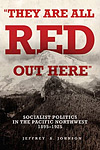book
"They are all Red Out Here": Socialist Politics in the Pacific Northwest, 1895-1925
by Jeffrey A. Johnson :: University of Oklahoma Press :: Reviewed by Keith Petersen '73

Few if any aspects of the Northwest’s political and labor history have been so thoroughly documented as the region’s most radical era, from the 1890s to the First World War. Books and articles have highlighted such topics as the rise of the Industrial Workers of the World (IWW), Idaho Governor Frank Steunenberg’s assassination, the Centralia Massacre of 1919, and a diversity of other subjects ranging from utopian communities to ethnically based radical politics. This time and these topics have captured the attention of several generations of historians.
So, the immediate question upon picking up a book with a title of They are all Red Out Here is this: is there room for yet another study of the region’s radical heritage? (Radical Heritage is, by the way, the title of another historian’s book about labor and socialism in the Pacific Northwest during this period.)
Author Jeffrey Johnson, who undertook much of the research for this book as a doctoral student at WSU, makes the case that there is. “Surprisingly few historians have explored early-twentieth-century grass-roots socialist activism and its repercussions in the Pacific Northwest, one of the nation’s most famously radical regions,” he writes [p. 4]. “The present volume provides the first broad regional history to examine socialist party activity across Washington, Oregon, Idaho, and Montana” [p. 7].
He has chosen a relatively small void. His goal is to separate “socialism” from other progressive and radical crusades of the time—particularly the labor movement—and to isolate and emphasize the Northwest socialist movement from the broader national trend. While the author must—and does—trace the parallel stories of other radical causes of the time, as well as the national Socialist Party activities, in order to place his account in context, he has found a niche and he has researched his story well.
Mining little-used papers, particularly at state historical societies in Montana, Idaho, Washington, and Oregon, Johnson does find ways to fill gaps in our knowledge of the period. His strength is in demonstrating the growth and demise of the Socialist Party and its struggle to, at various times, either align itself with or differentiate itself from other groups advocating contemporary progressive causes such as workers’ rights, temperance, the anti-war movement, and women’s suffrage. Trying to navigate these crowded waters while retaining a separate identity proved challenging for party officials. Indeed, the Socialist Party of Washington splintered into factions at the very height of the movement in 1913 because of differences in opinion over how to accomplish this, and the party never regained its pre-split prominence.
Of course, “prominence” is perhaps an overstatement. At the pinnacle of Socialist Party success, presidential candidate Eugene V. Debs won 5.9 percent of the national vote in 1912—10 percent in the “Red” states of Washington, Idaho, and Montana. By the time of the next presidential election in 1916, the party was in disarray, many of its key issues having been incorporated successfully into other social and political movements. Following America’s entrance into World War I in 1917, a growing suspicion and paranoia led to the Red Scare and the effective evisceration of the radical socialist movement.
Prior to its demise, Northwest socialists took boosteristic pride in modest political victories, turning extremely limited local successes into overhyped public relations achievements, stories retold with exaggerated fervor in the small but vibrant socialist press. Thus mayoral victories in Coeur d’Alene, Anaconda, and Butte, the winning of a city commission seat in Spokane, and the election of a constable in Thurston County became justification enough for the socialist press to claim such gains would “cause the enemy to take notice” [p. 59], while the party faithful awaited the “nearing revolution” [p. 65]. Even author Johnson gets caught up in the enthusiasm of his topic, stating the party “experienced extraordinary electoral success, making a significant imprint on regional politics” [p. 164].
In a few isolated communities, and for a brief number of years, the party did have a significant role. But the implications of this admittedly colorful—and at times brutally violent—time can easily be overstated. It was an interesting period in the region’s history, and it does deserve study—which it has received in this and other works.
One strength of this volume is to bring to light some significant local socialist figures who had previously been largely ignored, such as Butte mayor Lewis J. Duncan, Everett’s commissioner of public works J.M. Salter, and Idaho state senator Earl Bowman. Indeed, the author could have spent more time on these and other intriguing grass-roots characters, such as the Southwick, Idaho, party organizer who sent out this plea for support in 1912: “We’re pretty scattered out here, but I am carrying on the work. If any of the comrades have literature they would send me it would help a lot” [p. 104]. Delving even more deeply into the lives of these class warriors and the communities where they lived and worked could lend more texture to our understanding of this peculiar period in our region’s history.
The author has mined the voluminous secondary literature of the period well and he has added new insight with his own primary research, fleshing out, in addition to the stories of individual politicians and activists, the role of the regional socialist press, the development of socialist utopian communities, and the alternating courtship dance/battle stance between the Socialist Party and the regionally powerful IWW. Copiously documented and well organized in chronological fashion, They are all Red Out Here will become a standard reference for those who study the Pacific Northwest’s period of dalliance with radical politics.